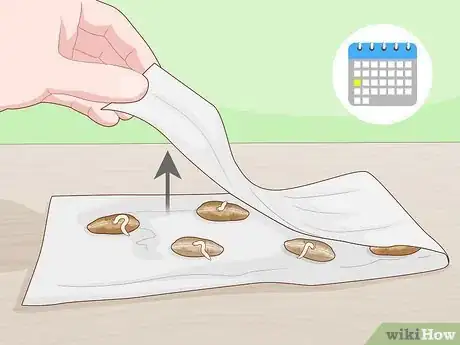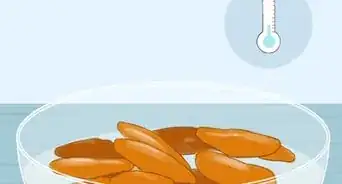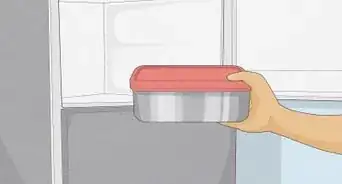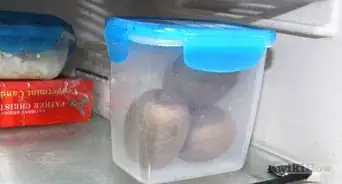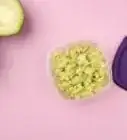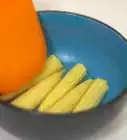This article was co-authored by wikiHow Staff. Our trained team of editors and researchers validate articles for accuracy and comprehensiveness. wikiHow's Content Management Team carefully monitors the work from our editorial staff to ensure that each article is backed by trusted research and meets our high quality standards.
There are 12 references cited in this article, which can be found at the bottom of the page.
This article has been viewed 34,107 times.
Learn more...
Dates are a delicious fruit grown on plants called date palms that love warm weather. They are known to grow well indoors as long as you give them lots of sun, though they tend to take many years to produce fruit. All you'll need are dates, potting soil, and a container for your seeds to start growing them. With a little time and care, you'll have beautiful date plants to enjoy year after year.
Steps
Germinating the Date Seed
-
1Split a few dates in half to remove the seeds. Purchase fresh date fruits from your local grocery store to get the seeds. Split the dates in half and pull out the large seeds, which are roughly the size of a pecan, to use in the germination process.[1]
- It’s best to use at least 4-5 date seeds just in case they don’t all germinate.
- It's easy to split dates in half just with your fingers by pulling them apart.
-
2Wash the seeds off to get rid of any pulp or extra fruit. Hold the seeds under clean running water so they’re clean. The cleaner the seeds, the less likely they are to grow mold or other bacteria as they’re germinating.[2]Advertisement
-
3Soak the seeds in a cup of water for 1-2 days to speed up germination. Fill a cup with room temperature water and place all of the seeds in it. Let the seeds sit in the water for at least a day or 2 at the most so that the seed coating absorbs as much water as possible.[3]
-
4Wrap the seeds up in a damp paper towel. Dampen a clean paper towel with fresh water so that it’s wet but not dripping. Place the seeds in the paper towel so they're spread out and fold the paper towel up so every side of each seed is completely covered.[4]
- Feel free to fold the paper towel multiple times to make it smaller.
-
5Place the paper towel in a sealed bag so the moisture can’t escape. Use a plastic bag or a plastic container that can seal tightly shut. Set the paper towel with the seeds in the bag or container and seal it so it’s airtight.[5]
- If the moisture in the paper towel is able to escape, your seeds will dry up and not be able to germinate.
-
6Put the bag in a warm, dark spot for a couple weeks. Setting your bag in a warm area helps create humidity so the seeds sprout roots more easily while the darkness helps with germination. Check on the seeds at least once or twice during these 2 weeks to make sure they’re still damp.[6]
- Try to set the bag or container in a spot that’s roughly 75 °F (24 °C) for the best results.
- If the paper towel has dried up, dampen it again with water carefully.
- You might place the bag in a warm cabinet in your kitchen or on the windowsill in a covered box.
-
7Remove the seeds 2 weeks later or once sprouts have begun to grow. Check on your seeds after the 2 weeks are up, unwrapping the paper towel carefully. Look for white sprouts growing from the seeds to show that they’re ready to be moved into the soil.[7]
- Even if sprouts have started to grow before the 2 weeks are up, it's still okay to wait the full 2 weeks so they grow stronger and more visible.
Potting the Date Seed
-
1Fill a small pot with palm soil or other well-draining nutrients. Pick out a container that’s at least 5 in (13 cm) wide and fill it with nutrient-rich potting soil. Use soil that has a mix of sand, vermiculite, and peat moss in it and fill the pot up about three-fifths of the way full.[8]
- Choose a container that has holes at the bottom so the water can drain out.
- A great vermiculite and sand ratio for the soil is 1:4 or 1:3, while you can also add 1 part peat moss.
- Peat moss is good for encouraging draining in your plant.
-
2Make small indentations 2 in (5.1 cm) apart from one another in the soil. Press your finger down into the soil to form the hole, making it 0.39 in (0.99 cm) to 1 in (2.5 cm) deep. Spread the holes out roughly 2 in (5.1 cm) from each other so the seeds have enough space to grow.[9]
- The seeds should also be 2 in (5.1 cm) away from the side of the pot.
-
3Place each seed into a hole and cover it up with soil. Gently set each seed down in a different hole with the sprout facing upwards instead of down into the soil. Sprinkle soil over each seed so that they’re fully covered and pat it down lightly.[10]
- The white sprout is where the leaves will eventually start to grow.
-
4Set the pot in an area that gets lots of morning sunlight. Dates love the sunlight and should be set in a spot that gets lots of sun each day. Place the pot near a window that receives several hours of morning sunlight if possible, and if not, in a spot that gets plenty of sun in the afternoon.[11]
-
5Soak the soil every time it gets dry. When you first set the seeds down in the soil, water the soil thoroughly to make sure all of it is moist. Check on the soil each day to see if it has dried out by placing your finger in it to test for dampness. If it feels dry, water it deeply again so the water reaches all the way down to the roots.[12]
- Avoid watering the soil when it’s still moist because this can lead to soggy roots.
- If the top 1 cm (0.39 in) of soil is dry, it's time to water it.
-
6Transfer the sprouting seeds to a larger pot when the roots become cramped. As your date seeds begin to grow, you’ll notice the roots start to grow out of the holes in the pot, signaling that it’s time for them to be put into a larger pot. When this happens, fill a larger pot with the same soil you used the first time, gently lift the date roots out of the old pot and into the new one, and water the dates and soil thoroughly.[13]
- The pot should be at least 4 in (10 cm) wider.
- Every week or two, pick up the pot and look to see if the roots have grown out of the holes. You may need to transfer the plant several times throughout its life.
- Create a hole in the top of the soil for the roots to be placed.
-
7Wait 7-8 years for fruits to grow. It takes a bit of time for date seeds to grow tall and strong enough to produce fruit. Keep watering and taking care of your date plant to watch it continue to get bigger. After roughly 7 or 8 years from when you planted the seed, your date plant should produce fruit for you to eat.[14]
- Water the date plant whenever the top layer of soil is dry and give it lots of access to sunlight.
- If you notice the roots growing out of the bottom of the pot, transfer the plant to a larger pot with fresh soil.
References
- ↑ https://www.youtube.com/watch?v=t_EcKQY6Tkw#t=15s
- ↑ https://www.youtube.com/watch?v=WN3RcoDiQlM#t=22s
- ↑ https://www.youtube.com/watch?v=WN3RcoDiQlM#t=51s
- ↑ https://www.youtube.com/watch?v=Ajtpw2tV6U0#t=55s
- ↑ http://www.edibletropicalplants.com/2014/08/how-to-grow-date-palms-from-seed.html
- ↑ https://www.youtube.com/watch?v=WN3RcoDiQlM#t=1m30s
- ↑ https://www.youtube.com/watch?v=Ajtpw2tV6U0#t=1m35s
- ↑ http://www.edibletropicalplants.com/2014/08/how-to-grow-date-palms-from-seed.html
- ↑ https://www.youtube.com/watch?v=WN3RcoDiQlM#t=2m16s






